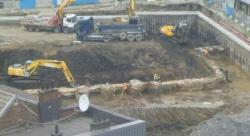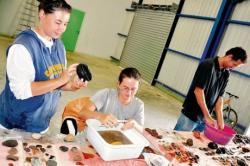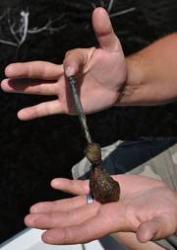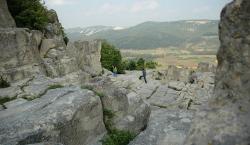- 14 SEPTEMBRE
- INDI-UNI : ANTHROPOLOGIE - ARCHEOLOGIE
INSCRIPTION 2011 – 2012 COURS A DISTANCE
REGISTRATION 2011 – 2012 ONLINE COURSES
- ISRAËL - Bat Yam - Israeli lifeguards plunged into the Mediterranean sea this month on an unusual rescue mission: to pull out an ancient ship's anchor. Lifeguard Avi Afia first spotted the tip of the anchor on a daily swim five years ago. It was peeking out from the sandy ocean floor about 150 feet (60 meters) from the coast. It wasn't until this month that the sands shifted to reveal the treasure in its entirety: a nearly 7-foot (2.1 meter), 650-pound (300 kilogram) iron anchor, probably a spare in the belly of a Byzantine ship that crashed and sank in a storm about 1,700 years ago, said archaeologist Jacob Sharvit of Israel's Antiquities Authority. The anchor dates back to the 4th or 5th century, estimated Sharvit, who heads the marine archaeology branch of Israel's Antiquities Authority. He said it attests to the vibrant sea trade of the Byzantine era, when merchant ships would carry oil, wine and stones for construction to ports along the coast and across the Mediterranean. The anchor also may point to a previously unknown ancient harbor on the coast, he added. He said his team of archaeologists would go diving this week to search for the rest of the shipwrecked treasure. He expects to find ancient wine and oil jugs, coins, the seafarers' personal items — and more anchors.
http://www.google.com/hostednews/ap/article/ALeqM5g5CFogjQw_3cikoVJcy0NEinnTCQ?docId=0ded966376964830a822c9e296d72a45
- BELGIQUE –  Charleroi - Pendant l’été déjà, le chantier d'aménagement de la place de la Digue avait permis de retrouver des anciennes fortifications du 17e siècle. Cette fois, c'est un énorme morceau de mur d'enceinte qui a été mis au jour. Pour les archéologues descendus sur place, c'est véritablement l'origine de Charleroi que les carolos peuvent voir en ce moment au milieu de l’énorme excavation. Ces vestiges devraient bientôt disparaitre pour laisser la place au parking sous-terrain en cours de construction. Dès lors, les archéologues de la Région Wallonne ont interpellé les autorités carolos pour tenter de valoriser au mieux ces découvertes.
Charleroi - Pendant l’été déjà, le chantier d'aménagement de la place de la Digue avait permis de retrouver des anciennes fortifications du 17e siècle. Cette fois, c'est un énorme morceau de mur d'enceinte qui a été mis au jour. Pour les archéologues descendus sur place, c'est véritablement l'origine de Charleroi que les carolos peuvent voir en ce moment au milieu de l’énorme excavation. Ces vestiges devraient bientôt disparaitre pour laisser la place au parking sous-terrain en cours de construction. Dès lors, les archéologues de la Région Wallonne ont interpellé les autorités carolos pour tenter de valoriser au mieux ces découvertes.
http://www.rtbf.be/info/regions/detail_les-travaux-de-charleroi-revele-des-remparts?id=6743913
- FRANCE –  Borie-Basse-Les Nébouts - Quatorze personnes sont à pied d'œuvre dans le cadre d'une mission d'archéologie préventive, conduite par le service départemental d'archéologie de la Dordogne sur le site de Borie-Basse-Les Nébouts, à Prigonrieux, là où va passer la rocade ouest bergeracoise. Ce panel de spécialistes, du géologue en passant par le palynologue, le carpologue ou la céramologue, au travail sur ce site depuis le 20 juin et jusqu'au 30 septembre, va permettre d'écrire une belle page d'histoire de l'occupation humai-ne de la rive droite de la Dordogne. Selon Yann Malhache, médiateur du patrimoine archéologique, la période mise à jour s'étend du néolithique jusqu'à 1100, au cœur du Moyen Âge. Et la moisson est déjà conséquente en silex taillés du néolithique (de -7000 à - 2000) et en céramiques caractéristiques de l'âge du bronze (de - 2000 à - 800), d'où un travail minutieux de collecte, de nettoyage, d'identification, de datation et de classification.
Borie-Basse-Les Nébouts - Quatorze personnes sont à pied d'œuvre dans le cadre d'une mission d'archéologie préventive, conduite par le service départemental d'archéologie de la Dordogne sur le site de Borie-Basse-Les Nébouts, à Prigonrieux, là où va passer la rocade ouest bergeracoise. Ce panel de spécialistes, du géologue en passant par le palynologue, le carpologue ou la céramologue, au travail sur ce site depuis le 20 juin et jusqu'au 30 septembre, va permettre d'écrire une belle page d'histoire de l'occupation humai-ne de la rive droite de la Dordogne. Selon Yann Malhache, médiateur du patrimoine archéologique, la période mise à jour s'étend du néolithique jusqu'à 1100, au cœur du Moyen Âge. Et la moisson est déjà conséquente en silex taillés du néolithique (de -7000 à - 2000) et en céramiques caractéristiques de l'âge du bronze (de - 2000 à - 800), d'où un travail minutieux de collecte, de nettoyage, d'identification, de datation et de classification.
http://www.sudouest.fr/2011/09/14/au-coeur-des-fouilles-archeologiques-498860-1733.php
- USA – Peace Haven - This is no ordinary site. It has enormous archaeological significance, having been occupied by native tribes for over 10,000 years, when humans started settling in the area following the end of the last ice age. The artifacts found at Peace Haven by Roy Athearn and other members of the Massachusetts Archaeological Society more than 50 years ago have figured in important scholarly works in the archaeology of Eastern North America. Peace Haven is generally regarded by professional archaeologists and the Massachusetts Historical Commission as one of the most important pre-contact sites in Southern New England. Using the more modern scientific analytical techniques available today, additional findings at Peace Haven are likely to yield further important information about Southern New England Native American cultures and their relationship to people in other regions. Peace Haven is also significant because of its association with King Philip’s War, when King Philip of the Pokanokets and Queen Weetamoe of the Pocassets fled with their warriors from the English on July 19,1675 after the battle of the Pocasset Swamp in Tiverton. They traveled along the Maury Path and arrived at Winslow Point at Peace Haven, crossed the Taunton River and then joined with the Nipmucks in central Massachusetts, thereby starting the war that changed the history of New England. After the battle of the Pocasset Swamp, had Captain James Cudworth and the English militia pursued and intercepted King Philip and Weetamoe at Winslow Point, the history of New England would have been quite different. Winslow Point was also the site of the Indian ferry that crossed the Taunton River. The ferry was operated by the Pocassets, and the preservation of the ferry is mentioned in the original Freetown Purchase.
http://www.heraldnews.com/archive/x1069123535/GUEST-OPINION-Understanding-the-significance-of-the-Meditech-site-at-Peace-Haven#ixzz1XwMiOd90
- USA –  Lac Monroe - Late one morning last week, Bosinski and archaeologists were finally able to identify what he and the team dubbed as "Mystery Wreck 1." It took awhile -- a lot of forwarded emails from different state officials and schedule wrangling -- for Bosinski to make contact with the archaeologists. But before the day's end, it turned into "Bosinski's Wreck 1" -- a boat, soon to be recorded in state records, more than 62 feet long. Bosinski had initially thought the wreck might be an old steamboat, but Moates said there were no signs of a steam engine. When Miller and Moates again resurfaced, they held a fastener and a burned piece of wood from the boat, making identification easier. Based on the style of the metal fastener, which was used to hold together the ship's planks and frames, Moates estimated the shipwreck to be from the 1920s or 1930s, although pinpointing a specific decade is imprecise based on such little information. After exploring more of the shipwreck, Moates' best guess on the type of boat is a fantail launch. It was probably a well-made pleasure boat. The burned wood, which was put back in the water along with the fastener, doesn't mean that fire led to the boat's demise, Moates said. Sometimes a sunken boat is lit on fire to make it easier to salvage some of its equipment.
Lac Monroe - Late one morning last week, Bosinski and archaeologists were finally able to identify what he and the team dubbed as "Mystery Wreck 1." It took awhile -- a lot of forwarded emails from different state officials and schedule wrangling -- for Bosinski to make contact with the archaeologists. But before the day's end, it turned into "Bosinski's Wreck 1" -- a boat, soon to be recorded in state records, more than 62 feet long. Bosinski had initially thought the wreck might be an old steamboat, but Moates said there were no signs of a steam engine. When Miller and Moates again resurfaced, they held a fastener and a burned piece of wood from the boat, making identification easier. Based on the style of the metal fastener, which was used to hold together the ship's planks and frames, Moates estimated the shipwreck to be from the 1920s or 1930s, although pinpointing a specific decade is imprecise based on such little information. After exploring more of the shipwreck, Moates' best guess on the type of boat is a fantail launch. It was probably a well-made pleasure boat. The burned wood, which was put back in the water along with the fastener, doesn't mean that fire led to the boat's demise, Moates said. Sometimes a sunken boat is lit on fire to make it easier to salvage some of its equipment.
http://www.news-journalonline.com/news/local/west-volusia/2011/09/14/mystery-boat-discovered-in-lake-monroe.html
- BULGARIE -  Perperikon - Archaeologists working at Bulgaria's ancient sacred site of Perperikon have found a mausoleum, with a sarcophagus inside containing a human skeleton believed to be that of a 14th century Ottoman conqueror, Bulgarian National Radio reported.
Perperikon - Archaeologists working at Bulgaria's ancient sacred site of Perperikon have found a mausoleum, with a sarcophagus inside containing a human skeleton believed to be that of a 14th century Ottoman conqueror, Bulgarian National Radio reported.
The building is oval, with a diameter of eight metres. The skeleton was found to have been laid out in accordance with Muslim custom, the report said. The remains are said to be those of Izrail, who in the 14th century led to a force of 300 soldiers to the site, then one of the most powerful fortresses in Bulgaria's Rhodope Mountains. Dozens of silver coins from the Ottoman era were found next to the mausoleum.According to leading Bulgarian archaeologist Professor Nikolai Ovcharov, the find opens a previously unknown page in the history of Perperikon and of the early Ottoman empire.
http://www.sofiaecho.com/2011/09/14/1155871_archaeology-mausoleum-of-ottoman-conqueror-found-at-perperikon
THAILANDE – Chanthaburi - The Culture Ministry has approved a Bt27million budget to build a diving training facility for underwater archaeology in Chanthaburi, in order to improve human resources and underwater site inspection. It is expected to be completed in 2014. Culture Minister Sukumol Khunploem explained that such training was previously done in the sea where, if there was a mistake, it could be fatally dangerous. As a result, the ministry asked for a facility building. The diving pool would be 12 to 20 metresdeep with an observation chamber in the bottom for a coach to observe divers during training, she said.
Fine Arts Department chief Somsuda Leeyawanich said the project organisers had studied China's Shang Hai underwater archaeology centre, which was the most modern of its kind in the AsiaPacific. She said the Office of Architecture was currently designing the diving facility, which was hoped to be the Asean hub of underwater archaeology and used by Unesco to train Asean countries' underwater archaeology divers.
http://www.nationmultimedia.com/home/Underwater-training-facility-for-Chanthaburi--30165279.html